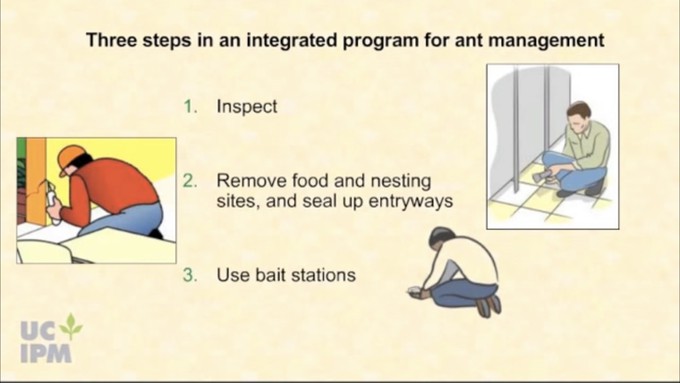
Rain, cold can send ants indoors

This is a screenshot from one of UCIPM's short videos on managing ants. Longer ones also are viewable on YouTube. Screenshot from UCIPM video "How to effectively control ants."
The first ones showed up on a shelf in the spice cabinet. They were easily dispatched. Then a few more appeared along the cupboard above the refrigerator, which is next to the coffee bar. They were easily removed, too, but I decided to relocate the just-refilled sugar bowl across the kitchen.
You know what happened next, right? The following day some intrepid ants had found the sugar bowl, and there was a thin line of their colleagues along the edge of the ceiling and down to the counter where the sugar now was. The battle was on.
With all the rain we’ve had, it’s a wonder the ants hadn’t invaded sooner. But these – very likely common Argentine ants – apparently were driven inside by the low-30s temperatures we’ve had this past week.
Fortunately, some quick work interrupted their incursion and they haven’t reappeared. (Knock on wood!) But it’s a good reminder that not every insect is dormant in winter. Pests live among us year-round, and it helps to be vigilant without resorting to overkill, i.e. pesticides.
The University of California Integrated Pest Management program offers a wealth of information on dealing with household and garden pests. UCIPM has pages and pages devoted to ants on the website, as well as several YouTube videos – quick 1-minute hits as well as longer explainers.
Part of the defense against ants indoors should be to remove whatever’s attracting them – pet food, cookie crumbs, (ahem) sugar bowl – then wipe the ants up with a soapy cloth or sponge, or use window cleaner. This destroys the trail being left for other ants. Also, try to find where they’re coming from outside, and caulk or block the entrance. Ant traps left near entrances will slow them down, though IPM experts note that it may take a week or so for traps to work. They caution against spraying for ants inside the home.
UC IPM presents a monthly Urban and Community Webinar on pest topics; past ones are recorded for later viewing. (Ants were discussed in October 2021.)
Here are the pest topics through April, all scheduled for noon to 1 p.m. Register at the Webinar link above to view them live.
Thursday, Feb. 16, “Dealing With Pantry Pests.”
Thursday, March 16, “Preventing Pest Problems at Seeding.”
Thursday, April 20, “Aphids, Scales and Mealybugs, Oh My.”
Meanwhile I’m on watch against future invaders – and replacing the sugar bowl with one featuring an airtight seal.
Comments
0 comments have been posted.Sacramento Digs Gardening to your inbox.
Sites We Like
Garden Checklist for week of May 12
Get your gardening chores and irrigation done early in the day before temperatures rise.
* Plant, plant, plant! It’s prime planting season in the Sacramento area. Time to set out those tomato transplants along with peppers and eggplants. Pinch off any flowers on new transplants to make them concentrate on establishing roots instead of setting premature fruit.
* Direct-seed melons, cucumbers, summer squash, corn, radishes, pumpkins and annual herbs such as basil.
* Harvest cabbage, lettuce, peas and green onions. This heat will cause leafy greens and onions to flower; pick them before they bolt.
* In the flower garden, direct-seed sunflowers, cosmos, salvia, zinnias, marigolds, celosia and asters.
* Plant dahlia tubers. Other perennials to set out include verbena, coreopsis, coneflower and astilbe.
* Transplant petunias, marigolds and perennial flowers such as astilbe, columbine, coneflowers, coreopsis, dahlias, rudbeckia and verbena.
* Keep an eye out for slugs, snails, earwigs and aphids that want to dine on tender new growth.
* Feed summer bloomers with a balanced fertilizer.
* For continued bloom, cut off spent flowers on roses as well as other flowering plants.
* Got fruit trees? If you haven't already done so, thin orchard fruit such as apples, peaches, pears, pluots and plums before they grow too heavy, breaking branches or even splitting the tree. Leave the largest fruit on the branch, culling the smaller ones, and allow for 5 to 6 inches (or a hand's worth) between each fruit.
* Thin grape bunches, again leaving about 6 inches between them. For the remaining bunches, prune off the "tail" end, about the bottom third of the bunch, so that the plant's energy is concentrated in the fruit closest to the branch.
* As spring-flowering shrubs finish blooming, give them a little pruning to shape them, removing old and dead wood. Lightly trim azaleas, fuchsias and marguerites for bushier plants.
* Add mulch to the garden to help keep that precious water from evaporating. Mulch also cuts down on weeds. But don’t let it mound around the stems or trunks of trees or shrubs. Leave about a 6-inch to 1-foot circle to avoid crown rot or other problems.